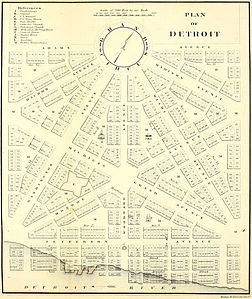M-1 (Michigan highway)
| Woodward Avenue | ||||
M-1 highlighted in red | ||||
| Route information | ||||
| Maintained by MDOT | ||||
| Length | 21.488 mi[1] (34.582 km) | |||
| Existed | 1970[2]–present | |||
| History | Woodward Avenue platted in 1805[2] and a state highway since 1913[3] | |||
| Tourist routes |
| |||
| NHS | Entire route[4] | |||
| Major junctions | ||||
| South end | Adams Avenue in Detroit | |||
| North end | Bus. US 24 near Pontiac | |||
| Location | ||||
| Country | United States | |||
| State | Michigan | |||
| Counties | Wayne, Oakland | |||
| Highway system | ||||
| ||||
M-1, also known as Woodward Avenue, is a north–south
The trunkline is the dividing line between Detroit's East and West sides and connects to some of the city's major freeways like Interstate 94 (I-94, Edsel Ford Freeway) and M-8 (Davison Freeway). Woodward Avenue exits Detroit at M-102 (8 Mile Road) and runs through the city's northern suburbs in Oakland County on its way to Pontiac. In between, Woodward Avenue passes through several historic districts in Detroit and provides access to many businesses in the area. The name Woodward Avenue has become synonymous with Detroit, cruising culture and the automotive industry.
Woodward Avenue was created after the
Route description
Like other state highways in Michigan, the section of Woodward Avenue designated M-1 is maintained by MDOT. In 2021, the department's traffic surveys showed that on
Detroit and Highland Park
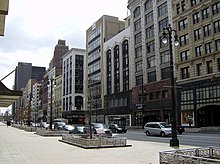
Woodward Avenue starts at an intersection with
North of Adams Avenue, Woodward Avenue is a state trunkline designated M-1. The highway crosses to the west of
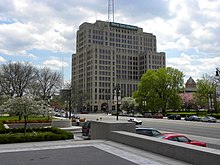
North of I-94, Woodward passes through
M-1 crosses back into Detroit at the intersection with McNichols Road;
Oakland County

Crossing the border into the suburb of
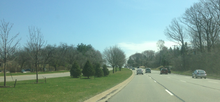
North of Birmingham, Woodward crosses through part of Bloomfield Township for the first time before entering Bloomfield Hills. That suburb's downtown is centered on the intersection with Long Lake Road; Woodward passes between a pair of golf courses north of there. The highway enters the south side of Pontiac's residential neighborhoods after crossing back into Bloomfield Township. At the intersection with Square Lake Road, M-1 terminates. Woodward Avenue continues northwesterly into Pontiac carrying the BL I-75 and Bus. US 24 designations; it terminates after the two directions of the boulevard diverge and form a one-way loop around the city's business district.[7][9]
Cultural significance
Scenic and historic designations

Many historical sites are located along Woodward Avenue, which was included in the MotorCities National Heritage Area when it was created on November 6, 1998.[19] The road was designated what is now called a Pure Michigan Byway by MDOT in 1999,[20] and a National Scenic Byway by the FHWA National Scenic Byways Program on June 13, 2002,[21] the only urban road at the time with that classification.[22] It was later upgraded to All-American Road status on October 16, 2009;[23] such roads have highly unique features and are significant enough to be tourist destinations unto themselves.[24] In announcing the byway status in 2002, Norman Mineta, then United States Secretary of Transportation, said that "Woodward Avenue put the world on wheels, and America's automobile heritage is represented along this corridor."[22]

The Woodward Avenue Action Association (WA3), the local agency that acts as the stewards and advocates for the All-American Road and Pure Michigan Byway designations as well as adjacent historical sites,[17] obtained a grant for $45,000 (equivalent to $60,000 in 2023[25]) from the FHWA in 2011 to install a set of 50 custom road signs along M-1 between Detroit and Pontiac.[26] WA3 sells replicas of these signs to discourage theft.[27][a] Profits are also being used along with money from clothing and other merchandise to support the Woodward Avenue Beautification Fund,[29] a special endowment created in 2010 to aid the 11 communities along the highway with maintenance and to defray costs associated with special events on the avenue.[30]
As well as the custom signage, WA3 has received FHWA grant funding to erect a series of lighted "tributes": solar-powered, lighted pillars that contain artwork related to the roadway. The $150,000 glass and concrete sculptures are being placed in the median along Woodward Avenue to serve as landmarks along the route of the roadway and to brand it for tourists. A total of 10 to 12 installations are planned for the length of the highway in Wayne and Oakland counties.[31] The art project received a 2011 National Scenic Byway Award for the Byways interpretation category.[32]
Religion, entertainment, and cars

The area around Woodward was once nicknamed "Piety Hill".[8] There are 22 churches on the NRHP along the street in Detroit and Highland Park.[33] According to The Detroit News, the sounds of church bells and horse hooves were some of the most distinctive sounds on Sundays along Woodward Avenue in the early 20th century.[8] The street was home to jazz clubs starting in the 1910s and 1920s, starting a period of transition.[34] During the 1940s, ministers lobbied for a law to prevent the issuance of additional liquor licenses in their neighborhood; the law was later overturned in 1950.[8] Nightclubs along Woodward hosted a burgeoning music scene in the early days of rock 'n roll,[34] and the area also had plenty of bars and burlesque shows as late as the 1970s. One local journalist called the mix of churches, clubs, and bars along Woodward Avenue "a precarious balance between the sacred and the profane".[8]
As well as music clubs, many of Detroit's other major entertainment venues are located on or near Woodward in downtown Detroit, including the
Woodward Avenue's connection to Detroit's automobile culture dates to the early 20th century. Around 100 automobile companies were founded along the roadway.
Woodward Dream Cruise

Young carriage drivers raced one another along Woodward Avenue after the roadway was converted from logs to planks in 1848. They placed bets on each other's carriages while racing from tavern to tavern.[8] By 1958, the roadway was used for unofficial street racing with cars. The wide width, median and sections lacking a large commercial presence attracted a reputation for the competition. The numerous drive-ins, each with its dedicated local teenaged clientele, were also popular. Woodward had numerous car dealerships and automobile accessory shops in the age of the muscle car which completed the formula for young adults to "cruise", race and hang out along the road.[45]
The Woodward Dream Cruise takes place on Woodward Avenue between Pontiac and Ferndale during August of each year, evoking nostalgia of the 1950s and 1960s, when it was common for young drivers to cruise with their cars on Woodward Avenue. The event attracts huge crowds of classic car owners and admirers from around the world to the Metro Detroit area in celebration of Detroit's automotive history;[46] an estimated one million spectators attended the 2009 event.[47] The cruise was founded in 1995 as a fundraiser for a soccer field in Ferndale. Neighboring cities joined in, and by 1997, auto manufacturers and other vendors had begun sponsoring the event.[46]
History
Indian trails and plank roads
In 1701, the first transportation routes through what became the state of Michigan were the lakes, rivers and Indian trails. One of these, the
Augustus Woodward was a judge in the Michigan Territory appointed by his friend, President Thomas Jefferson.[51] He was also a colonel in the territorial militia and a president of one of Detroit's first banks.[53] Woodward named the street for himself, responding whimsically to the resulting criticism: "Not so. The avenue is named Woodward because it runs wood-ward, toward the woods."[51][c] Other proposals for names included Court House Street or Market Street. For a time, one section was named Congress Street, Witherell Street, Saginaw Road or Saginaw Turnpike,[51] with another section dubbed Pontiac Road. Unlike these other monikers, the avenue retained the judge's name.[2]
Detroit was incorporated in 1815,[22] and the initial roadway to connect Detroit north to Pontiac along the Saginaw Trail was started in 1817; this was a corduroy road built by laying down logs and filling in the gaps with clay or sand.[54] The territorial legislature authorized a survey of the roadway to Pontiac on December 7, 1818, and the route was approved by Governor Lewis Cass on December 15, 1819,[55] the first to be done in the future state.[56] The Michigan Legislature authorized the construction of a private plank road with tolls to connect Detroit with Pontiac in 1848. By the next year, 16-foot-wide (4.9 m) and 3-inch-thick (7.6 cm) oak planks were laid along the road between the two communities. Tolls were one cent per mile (0.62 ¢/km) for vehicles and two cents per mile (1.2 ¢/km) for a herd of cattle. Tolls along some segments of Woodward Avenue remained in place as late as 1908.[57]
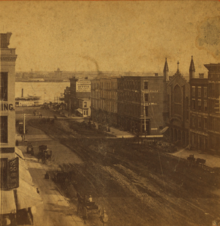
The first automobile in Detroit was driven by Charles Brady King along Woodward Avenue on March 3, 1896, a few weeks before Henry Ford drove his first car in the city.[58] In 1909, the first mile (1.6 km) of concrete roadway in the country was paved between 6 and 7 Mile roads at a cost of $14,000 (equivalent to $340,000 in 2023[25]).[51][59]
State Trunkline era
On May 13, 1913, the Legislature created the state's highway system; Woodward Avenue was included as part of "Division 2".[3] The full length was paved in 1916.[2] The first crow's nest traffic tower in the US was installed at the intersection of Woodward and Michigan avenues on October 9, 1917; the tower elevated a police officer above the center of the intersection to direct traffic before the structure was replaced in October 1920 with the world's first four-way traffic light.[51] The state signposted its highways in 1919,[60] and Woodward Avenue was assigned the M-10 designation.[61] The same year, two auto trail designations were applied to the avenue. The Theodore Roosevelt International Highway was created in February 1919, running from Detroit northward along Woodward Avenue.[62] Later that year, the Dixie Highway was extended through Detroit to the Straits of Mackinac,[63] following the route of the old Saginaw Trail northward along Woodward Avenue.[64]
Since 1924,
Legal disputes over a plan to widen Woodward Avenue dating back to 1874 were resolved in 1932. Permission was needed from a majority of the landowners along Woodward Avenue to finalize the deal.[2] John W. Chandler, general manager of the Woodward Avenue Improvement Association,[69] pledged not to shave his face until he had the necessary permissions in hand. This resolution allowed Woodward to be widened from 66 to 120 feet (20 to 37 m). Several buildings were removed to clear the wider street path, and St. John's Episcopal Church was moved 60 feet (18 m) to avoid demolition.[2] Work started in 1933 and cost $7.5 million (equivalent to $140 million in 2023[25]) to complete.[57]

A bypass of downtown Birmingham opened in 1939, drawing through traffic away from the busy Woodward Avenue–Maple Road intersection. The bypass was originally named Hunter Boulevard.[70] On September 6, 1997, Birmingham renamed the bypass to Woodward Avenue, with the previous alignment of Woodward signed as Old Woodward Avenue.[71]
In October 1969, AASHO approved a realignment of US 10 in the Detroit area;
In the early 1980s, M-1 was truncated in downtown Detroit, as the Woodward Mall was designated in the area around Cadillac Square.[75][76] At the end of 2000, MDOT proposed several highway transfers in Detroit. Some of these involved transferring city streets in the Campus Martius Park area under the department's jurisdiction to city control; another part of the proposal involved MDOT assuming control over a section of Woodward Avenue from Adams Avenue south to Grand River Avenue.[77] These transfers were completed the following year.[78][79] In 2004, the southern terminus was moved north three blocks to Adams Avenue.[80][81] A massive address renumbering project ensued along Woodward Avenue in 1997, creating a consistent numbering system from downtown Detroit to Pontiac. Previously, each city along the route had its own address system.[82] In June 2017, the southernmost block of Woodward Avenue south of Larned Street closed to automobiles to create a temporary pedestrian plaza.[83] This closure was made permanent the following November.[84]
Streetcars and other public transportation

On August 27, 1863, the Detroit City Railway Company (DCRC) established streetcar service along Woodward from Jefferson to Adams avenues.[85] The company was formed by investors from Syracuse, New York, earlier that year. Later, on September 18, 1886, a separate electrified line, the Highland Park Railway, was added that ran along Woodward Avenue through Highland Park.[86] In mid-December 1893, the main streetcar line was electrified by the DCRC.[87] In 1901, the various lines throughout the city were consolidated as the Detroit United Railway.[88]
Detroit took control of the Detroit Unified Railway on May 15, 1922; afterwards, the streetcar system became the city's
The streetcar system, like those in other cities across the US, fell into decline after

In the first decade of the 21st century, local business and government officials proposed two projects to add modern streetcars to M-1, an approximately nine-mile-long (14 km) line from the transit center at Michigan Avenue north to the state fairgrounds,[93] or a 3.4-mile (5.5 km) line in the downtown area only.[94] Suggestions to unify the two plans were made in late 2008,[95] and the Detroit City Council approved the sale of $125 million in bonds on April 11, 2011, for the longer system.[93] Through various approvals in 2011,[96] and subsequent changes including a bus rapid transit system[97] with a dedicated Woodward Avenue bus lane,[98] private investors who supported the shorter three-mile line to New Center continued developing that project.[99]
On July 28, 2014, construction started for a streetcar line to stretch from downtown Detroit to Grand Boulevard in New Center. The line was to have 20 different stations serving 12 stops, with most of the stations curbside on either side of Woodward Avenue going uptown or downtown. The line will have center road stations at the north and south ends of the system.[100] Named QLine in 2016, the system opened in May 2017.[101] The last car of Detroit's previous streetcar system was numbered 286, so the planners numbered the cars for the new line 287–292 to pick up where the old number series had left off.[102]
Major intersections
| County | Location | mi[1] | km | Destinations | Notes |
|---|---|---|---|---|---|
Detroit | 0.000 | 0.000 | Adams Avenue Woodward Avenue south | Southern terminus of M-1; Woodward Avenue continues to Jefferson Avenue | |
| 2.053– 2.065 | 3.304– 3.323 | Indirect access from exit 215C on eastbound I-94 | |||
Davison Freeway ) | |||||
Detroit–Ferndale city line | 8.453– 8.463 | 13.604– 13.620 | Three-level diamond interchange | ||
| Oakland | Royal Oak | 10.688– 10.700 | 17.201– 17.220 | Exit 16 on I-696 | |
Bus. US 24 (Square Lake Road west, Woodward Avenue north) | Northern terminus of M-1; Woodward Avenue continues into downtown Pontiac | ||||
| 1.000 mi = 1.609 km; 1.000 km = 0.621 mi | |||||
See also
Notes
- ^ Another highway, M-22 in Northern Michigan has also been the subject of sign theft with different methods used to deter sign removal.[28]
- ^ Detroit was incorporated as a town in 1802 by the government of the Northwest Territory before incorporation and reincorporation as a city by the Michigan Territory in 1806 and 1815.[49]
- ^ Woodward used other similar word plays to explain street names, according to George Catlin, a Detroit historian. "Atwater Street, the Judge said, was not named for Reuben Atwater, but because it was literally 'at water,' being on the riverfront".[2]
- ^ Since July 1, 1974, the Department of Street Railways has been renamed the Detroit Department of Transportation, the agency responsible for the city's bus system. That bus system was started in 1925 as a feeder network to serve the streetcar lines.[88]
References
- ^ a b Michigan Department of Transportation (2021). Next Generation PR Finder (Map). Michigan Department of Transportation. Retrieved October 11, 2021.
- ^ OCLC 137348716. Archived from the originalon January 4, 2009. Retrieved June 6, 2012.
- ^ .
- ^ a b Michigan Department of Transportation (2023). National Functional Classification (Map). Michigan Department of Transportation. Retrieved July 18, 2023.
- ^ Michigan Department of Transportation (2023). Traffic AADT Map (Map). Michigan Department of Transportation. Retrieved July 18, 2023.
- ^ Natzke, Stefan; Neathery, Mike & Adderly, Kevin (June 20, 2012). "What is the National Highway System?". National Highway System. Federal Highway Administration. Archived from the original on July 4, 2012. Retrieved July 1, 2012.
- ^ OCLC 951112618.
- ^ OCLC 137348716. Archived from the originalon January 2, 2015. Retrieved July 16, 2012.
- ^ a b c d e f g h i Google (May 21, 2017). "Overview Map of M-1" (Map). Google Maps. Google. Retrieved May 21, 2017.
- ^ Michigan Department of Natural Resources (n.d.). Ford Motor Company (Michigan State Historical Marker). Hart Plaza, Detroit: Michigan Department of Natural Resources. Archived from the original on December 21, 2013. Retrieved December 8, 2012 – via Flickr.
- .
- ^ Gross, Allie (July 23, 2019). "Detroit City Council Votes to Keep Spirit of Detroit Plaza Downtown". Detroit Free Press. Retrieved August 11, 2022.
- ^ Federal Highway Administration (n.d.). "Woodward Avenue Auto History Tour". America's Byways. Federal Highway Administration. Archived from the original on February 9, 2010. Retrieved December 8, 2012.
- ^ Michigan Department of Transportation (n.d.). "National Firsts". Michigan Department of Transportation. Archived from the original on January 21, 2017. Retrieved May 21, 2017.
- ^ Michigan State Housing Development Authority (June 22, 2012). "Highland Park Ford Plant". Historic Sites Online. Michigan State Housing Development Authority. Archived from the original on December 23, 2012. Retrieved December 12, 2012.
- ^ National Park Service (n.d.). "Highland Park Ford Plant". Detroit: A National Register of Historic Places Travel Itinerary. National Park Service. Archived from the original on December 20, 2012. Retrieved December 12, 2012.
- ^ OCLC 746155690.
- ^ OCLC 45227386.
- The History Channel (n.d.). "Nov 6, 1998: President Clinton designates 'Automobile National Heritage Area' in Detroit". This Day in History. The History Channel. Archivedfrom the original on November 4, 2012. Retrieved April 23, 2012.
- Newspapers.com.
- Crain's Detroit Business. Archivedfrom the original on July 2, 2017. Retrieved July 1, 2017.
- ^ a b c Michigan Department of Transportation (Winter 2003). "Woodward Avenue: A Road to the Heart and Soul of America" (PDF). MDOT Today. Michigan Department of Transportation. pp. 8–9. Archived (PDF) from the original on June 16, 2012. Retrieved August 30, 2009.
- MLive. Detroit: Booth Newspapers. Archivedfrom the original on July 23, 2014. Retrieved July 14, 2012.
- ^ Federal Highway Administration (August 17, 2011). "America's Byways Fact Sheet" (PDF). America's Byways. Federal Highway Administration. Archived from the original (PDF) on September 11, 2012. Retrieved September 22, 2012.
- ^ Gross Domestic Product deflatorfigures follow the MeasuringWorth series.
- ^ Shine, Kim North (February 23, 2011). "Woodward Avenue Gets 50 New Signs, All-American Road Designation". Prosper. Pontiac, Michigan: Oakland County. Archived from the original on February 25, 2014. Retrieved July 24, 2012.
- ^ Welch, Sherri (June 23, 2011). "Capitalizing on the Theft of 'All-American Road' Signs on Woodward". Crain's Detroit Business Staff Blogs. Archived from the original on November 17, 2015. Retrieved July 1, 2017.
- ^ Johnson, Mark (August 23, 2016). "Modifying M-22: MDOT Changing Signs to Discourage Theft". Traverse City Record-Eagle. Archived from the original on August 1, 2021. Retrieved August 25, 2016.
- ^ Oosting, Jonathan (December 15, 2011). "Woodward on a Onesie: New Merch Celebrates, Benefits Metro Detroit's 'All-American Road'". MLive. Detroit: Booth Newspapers. Archived from the original on February 23, 2014. Retrieved July 28, 2012.
- ^ Welch, Sherri (February 26, 2010). "Woodward Avenue Action Association Creates Fund to Help Municipalities". Crain's Detroit Business. Archived from the original on March 4, 2010. Retrieved August 1, 2013.
- ^ Kavanaugh, Catherine (April 18, 2012). "Royal Oak Auto Designer Pays Tribute to Woodward Avenue". The Daily Tribune. Mount Clemens, Michigan. Archived from the original on June 10, 2015. Retrieved July 24, 2012.
- ^ Carmona, Heather (n.d.). "Woodward Avenue Tribute Program" (PDF). Woodard Avenue Action Association. Archived from the original (PDF) on July 7, 2015. Retrieved July 24, 2012.
- ^ National Park Service (January 23, 2007). "National Register Information System". National Register of Historic Places. National Park Service. Archived from the original on December 4, 2010. Retrieved July 17, 2012.
- ^ OCLC 137348716. Archived from the originalon June 10, 2015. Retrieved July 16, 2012.
- ^ "Metro Detroit's Largest Performance Venues". Crain's Detroit Business. August 31, 2012. Archived from the original on March 19, 2018. Retrieved May 22, 2017.
- ^ Experience Detroit (n.d.). "Detroit Theatres". Experience Detroit. Archived from the original on July 23, 2016. Retrieved July 1, 2017.
- OCLC 929048780. Retrieved May 22, 2017 – via Google Books.
- ^ Hodges, Michael H. (September 8, 2003). "Fox Theater's Rebirth Ushered in City's Renewal". Michigan History. The Detroit News. Archived from the original on December 5, 2012. Retrieved November 23, 2007.
- ^ Detroit Economic Growth Corporation (n.d.). "Arts & Culture". Detroit Economic Growth Corporation. Archived from the original on October 9, 2013. Retrieved July 24, 2008.
Detroit is home to the second largest theatre district in the United States.
- Forbes. Archivedfrom the original on January 30, 2017. Retrieved May 21, 2017.
- ^ Model T Automotive Heritage Complex (n.d.). "History of the Model T Factory: Development of the Model T". Model T Automotive Heritage Complex. Archived from the original on October 18, 2012. Retrieved December 8, 2012.
- Detroit Historical Society (n.d.). "Highland Park Ford Plant". Encyclopedia of Detroit. Detroit Historical Society. Archivedfrom the original on September 30, 2016. Retrieved July 1, 2017.
- ^ Shea, Bill (August 18, 2008). "Detroit Had Light Rail Until the 1950s". Crain's Detroit Business. Archived from the original on March 9, 2021. Retrieved August 20, 2012.
- ^ Woodward Avenue Action Association (n.d.). Birthplace of the Automobile Industry (Pamphlet). Woodward Avenue Action Association. Archived from the original on August 1, 2021. Retrieved August 1, 2021 – via Yumpu.
- OCLC 505927336.
- ^ a b Genat (2010), pp. 124–125.
- . Retrieved July 13, 2018 – via Newspapers.com.
- OCLC 23314983.
- Digital Collections.
- OCLC 435640179.
- ^ OCLC 57425393.
- ^ Hull, William; Woodward, Augustus B. & Bates, Frederick (1871) [enacted September 18, 1805]. "An Act Concerning Highways and Roads". Laws of the Territory of Michigan. Vol. Vol. 1. Lansing, Michigan: W.S. George & Co. pp. 75–79. Retrieved April 24, 2017 – via Google Books.
- OCLC 137348716. Archived from the originalon July 7, 2012. Retrieved October 20, 2012.
- .
- ^ Barnett (2004), pp. 192–193.
- ^ Michigan Department of Transportation (June 18, 2010). "Road & Highway Facts". Michigan Department of Transportation. Archived from the original on February 8, 2012. Retrieved September 27, 2010.
- ^ a b Gavrilovich & McGraw (2000), pp. 236–238.
- from the original on July 13, 2018. Retrieved September 21, 2012.
- ^ OCLC 18030507. Retrieved July 13, 2018 – via Newspapers.com.
- OCLC 9975013.
- OCLC 15607244. Retrieved October 17, 2019 – via Michigan History Center.
- OCLC 80156759.
- OCLC 11658858. Retrieved July 13, 2018 – via Newspapers.com.
- OCLC 35066537.
- ^ KPTV-TV. Archived from the originalon December 24, 2013. Retrieved November 20, 2012.
- ^ "See the Official Parade Route: Woodward Ave. Comes Alive with America's Thanksgiving Parade". Click On Detroit. Detroit: WDIV-TV. November 13, 2006. Archived from the original on June 9, 2011. Retrieved May 26, 2011.
- OCLC 63377558.
- .
- OCLC 9517291. Retrieved September 23, 2012 – via FultonHistory.com.
- OCLC 9948897. Archived from the original(PDF) on April 25, 2017. Retrieved April 24, 2017 – via Bloomfield Township Public Library.
- ^ Woodward Avenue Action Association (September 3, 1997). "'Sign of the Times' Sponsored by Woodward Avenue Action Association and the Birmingham Principal Shopping District" (Press release). Birmingham, Michigan: Woodward Avenue Action Association. Archived from the original on April 25, 2017. Retrieved April 24, 2017 – via PR Newswire.
- American Association of State Highway Officials. p. 2. Retrieved August 2, 2014 – via Wikisource.
- OCLC 12701177. Retrieved October 17, 2019 – via Michigan History Center.
- OCLC 12701177. Retrieved October 17, 2019 – via Michigan History Center.
- . Retrieved October 17, 2019 – via Michigan History Center.
- on August 27, 2019. Retrieved August 26, 2019 – via Archives of Michigan.
- ^ Michigan Department of Transportation (November 7, 2000). Proposed Jurisdiction Transfers in the City of Detroit (PDF) (Map). Scale not given. Lansing: Michigan Department of Transportation. Archived (PDF) from the original on May 23, 2012. Retrieved January 12, 2012 – via Michigan Highways.
- OCLC 42778335. Retrieved October 17, 2019 – via Michigan History Center.
- OCLC 42778335.
- .
- .
- . Retrieved July 11, 2021 – via Newspapers.com.
- ^ Pinho, Kirk (June 8, 2017). "Woodward Closing to Cars South of Larned for Downtown Pedestrian Plaza". Crain's Detroit Business. Archived from the original on May 21, 2019. Retrieved November 1, 2018.
- ^ Ikonomova, Violet (November 21, 2017). "Woodward Avenue Street Plaza to Stay Open Despite Traffic Concerns". Metro Times. Detroit. Archived from the original on November 22, 2017. Retrieved November 1, 2018.
- OCLC 67975025. Retrieved April 24, 2017 – via Google Books.
- ^ Schramm (2006), p. 7.
- ^ Zachary and Associates (July 30, 1997). "Historic and Architectural Resources of the Cass Farm Survey Area, Detroit, Wayne County, Michigan" (PDF). National Register of Historic Places. National Park Service. p. 5. Archived (PDF) from the original on November 17, 2015. Retrieved August 20, 2012.
- ^ a b c Schramm (2006), p. 8.
- ^ OCLC 182530522. Retrieved October 22, 2012 – via Google Books.
- OCLC 5463777. Archived from the original on December 27, 2013. Retrieved October 8, 2012 – via Google Play Books.
- OCLC 10024235. Archived from the originalon March 17, 2012. Retrieved October 22, 2012.
- from the original on June 19, 2012. Retrieved August 20, 2012.
- ^ a b "City Council Approves Detroit Light Rail Project". Detroit: WWJ-TV. April 12, 2011. Archived from the original on March 16, 2012. Retrieved July 15, 2012.
- ^ Oosting, Jonathan (November 2, 2009). "Woodward Light-Rail Project in Detroit Could Lose Matching Federal Funds for Extension". MLive. Detroit: Booth Newspapers. Archived from the original on January 16, 2014. Retrieved October 5, 2012.
- The Michigan Messenger. Archived from the originalon February 16, 2010. Retrieved October 8, 2012.
- ^ Wayland, Michael (September 6, 2011). "Detroit's Woodward Ave. Light Rail Project Moves Forward, but Still Has Long Road to Completion". MLive. Detroit: Booth Newspapers. Archived from the original on October 19, 2013. Retrieved December 15, 2011.
- . Retrieved July 13, 2018 – via Newspapers.com.
- ^ AlHajal, Khalil (December 17, 2012). "Detroit-Area Group to Check Out Cleveland's Bus Rapid Transit System After Legislation Opens Doors". MLive. Detroit: Booth Newspapers. Archived from the original on December 23, 2012. Retrieved December 27, 2012.
- . Retrieved July 13, 2018 – via Newspapers.com.
- OCLC 9729223.
- . Retrieved July 13, 2018 – via Newspapers.com.
- ^ Raven, Benjamin (September 21, 2016). "Take a Peek Inside Detroit's First QLine Streetcar". MLive. Detroit: Booth Newspapers. Archived from the original on October 10, 2016. Retrieved December 14, 2016.
External links
 Geographic data related to M-1 (Woodward Avenue) at OpenStreetMap
Geographic data related to M-1 (Woodward Avenue) at OpenStreetMap- M-1 at Michigan Highways
- Woodward Avenue (M-1) Automotive Heritage Trail National Scenic Byway at America's Byways (Federal Highway Administration)
- Official Byway Homepage, Woodward Avenue Action Association
- The Woodward Dream Cruise



